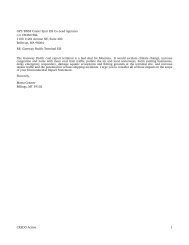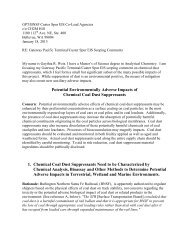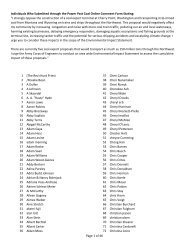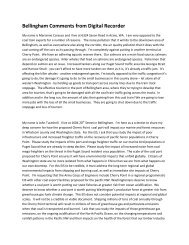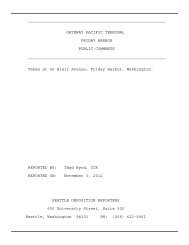Lummi Indian Business Council - EISs for the Proposed Gateway ...
Lummi Indian Business Council - EISs for the Proposed Gateway ...
Lummi Indian Business Council - EISs for the Proposed Gateway ...
You also want an ePaper? Increase the reach of your titles
YUMPU automatically turns print PDFs into web optimized ePapers that Google loves.
6.3 Significant Unavoidable Adverse ImpactsConstruction and operation of <strong>the</strong> proposed projects will degrade finfish and shellfish habitatwithin a primary harvest area relied on by <strong>the</strong> <strong>Lummi</strong> People to exercise <strong>the</strong>ir treaty rights tofish throughout <strong>the</strong>ir U&A – <strong>the</strong>se impacts will result in significant, unavoidable, andunacceptable interference with our treaty rights and irreversible and irretrievable damage toour spiritual values if <strong>the</strong> proposed projects are approved.7 Potential Impact: Climate Change7.1 Issue Definition/Rationale:Greenhouse gases like water vapor, carbon dioxide, methane, nitrous oxide, and ozone absorbenergy and slow or prevent <strong>the</strong> loss of heat from <strong>the</strong> Earth into space. These atmosphericgases increase when <strong>the</strong> emissions of <strong>the</strong>se gases exceed <strong>the</strong> rate that <strong>the</strong>y can be absorbed by<strong>the</strong> ocean or by terrestrial plants. Because <strong>the</strong> greenhouse gases slow or prevent heat fromescaping back into space, <strong>the</strong> Earth becomes warmer, which is known as global warming.Because of <strong>the</strong> role of temperature and temperature differences over <strong>the</strong> Earth surface onclimate, global warming causes changes in climate. According to <strong>the</strong> EPA, carbon dioxide (CO 2 )is <strong>the</strong> primary greenhouse gas that is contributing to climate changes observed since <strong>the</strong>Industrial Revolution began in <strong>the</strong> mid‐1700s. Atmospheric CO 2 concentrations have increasedby approximately 40 percent since <strong>the</strong> Industrial Revolution. Although <strong>the</strong>re are naturalsources of CO 2 (e.g., volcanic eruptions), most of <strong>the</strong> carbon emitted to <strong>the</strong> atmosphere is dueto <strong>the</strong> combustion of fossil fuels and de<strong>for</strong>estation.According to <strong>the</strong> EPA, coal‐fired power plants emit 1.3 times more carbon dioxide than <strong>the</strong>average petroleum oil‐fired power plant and 2 times more carbon dioxide than an averagenatural gas‐fired power plant. Fur<strong>the</strong>r increases in CO 2 are expected to lead to higher sealevels, greater coastal flooding, more intense wea<strong>the</strong>r patterns/storms, retreat/melting ofglaciers, and ocean acidification. If constructed, <strong>the</strong> proposed project will substantially increase<strong>the</strong> availability of coal on <strong>the</strong> global market, which can be expected to decrease <strong>the</strong> cost of coal.As <strong>the</strong> cost of coal decreases, economic incentives to develop alternative energy sources thathave lower CO 2 emissions also decrease, which will continue <strong>the</strong> reliance on an energy sourcethat has relatively high levels of CO 2 emissions.Stream flow in <strong>the</strong> Nooksack River, particularly in <strong>the</strong> North and Middle Forks of <strong>the</strong> river, aresupported by glacial melt and runoff during <strong>the</strong> summer months. As <strong>the</strong> glaciers continue toretreat, less runoff will be able to support stream flows during <strong>the</strong> low‐flow summer months.These stream flows are needed to support a sustainable, harvestable surplus of salmon.7.2 Extent/Geographic Scale of EvaluationImmediate AreaLocal AreaRegional Area<strong>Lummi</strong> Nation Scoping CommentsCorps Project Ref. No. NWS‐2008‐260Corps Project Ref. No. NWS‐2011‐325January 201312



